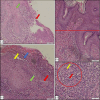Extensive Condyloma Lata Lesions in Unusual Sites: An Atypical Manifestation of Secondary Syphilis
- PMID: 41049481
- PMCID: PMC12490915
- DOI: 10.1155/carm/8595258
Extensive Condyloma Lata Lesions in Unusual Sites: An Atypical Manifestation of Secondary Syphilis
Abstract
Condyloma lata is a typical lesion of secondary syphilis, which usually occurs in the flexural and anogenital areas. Secondary syphilis can be misdiagnosed with atypical clinical manifestations that can mimic other skin diseases (the great imitator), especially in patients with human immunodeficiency virus (HIV) infection. Atypical condyloma lata lesions can occur outside the flexural and extragenital areas. Therefore, it can mimic other skin diseases. This case report aims to report a case of secondary syphilis in the form of extensive condyloma lata lesions in unusual sites in a 46-year-old man with HIV Stage II. Physical examination revealed flat papules and plaques on the face, trunk, and anogenital area; papules with excoriations on the extremities; and mucous patches. Treponema pallidum hemagglutination assay and Venereal Disease Research Laboratory (VDRL) titer were 1:5120 and 1:256, respectively. The Chlamydia trachomatis and hepatitis C examination, as well as CD4+ T cell count and HIV viral loads data, were unavailable for this patient. Histopathological findings from flat papules on the patient's face, abdomen, and inguinal region showed eroded epidermis with neutrophil infiltration, spongiotic reactions, acanthosis, parakeratosis, hypogranulosis, superficial pallor, and endarteritis with the infiltration of plasmocytes and polymorphonuclear cells, which support that the patient's lesion is condyloma lata. The patient was treated with a single dose of 2.4 million units of benzylpenicillin G intramuscularly. The result of VDRL titer examination after 3 months of therapy was 1:32, with improvement in the skin lesions seen as the lesions that became hyperpigmentation macules. This case report showed condyloma lata, a hallmark of secondary syphilis, can present as extensive lesions in extragenital sites. Awareness of the atypical manifestations is essential to ensure early diagnosis through histopathological and serological evaluation.
Keywords: extragenital lesions; great imitator; human immunodeficiency virus infection; penicillin therapy; sexually transmitted infection.
Copyright © 2025 Retno Hesty Maharani et al. Case Reports in Medicine published by John Wiley & Sons Ltd.
Conflict of interest statement
The authors declare no conflicts of interest.
Figures



References
-
- Tuddenham S. A., Zenilman J. M. Syphilis. In: Kang S., Amagai M., Bruckner A. L., Enk A. H., Margolis D. J., McMichael A. J., editors. Fitzpatrick’s Dermatology in General Medicine . 9th. New York: McGraw-Hill; 2019. pp. 3145–3172.
-
- Centers for Disease Control and Prevention (CDC) Syphilis. National Overview: Sexually Transmitted Disease Surveillance. https://www.cdc.gov/std/statistics/2022/overview.htm .
Publication types
LinkOut - more resources
Full Text Sources
Research Materials

